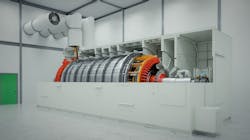Amprion Develops Rotating Asynchronous Phase Shifter
When conventional power generation declines, additional technical measures are needed to ensure the stability of the electricity grids. The energy transition in Germany is prompting the four German transmission system operators (TSOs) to take compensatory measures to keep the grid voltage at the required level.
An essential factor in maintaining voltage is reactive power, and TSOs respond to changes in the energy landscape by installing reactive power systems to compensate for the loss of reactive power previously provided by conventional power plants. Reactive power is particularly required for the AC transmission of large amounts of energy over long distances. This is likely to be a common practice in the energy future of Germany.
The German TSO Amprion and Siemens Energy plan to develop and install a rotating asynchronous phase shifter with a high output of about 300 MVA. The device is called ARESS: Asynchronous Rotating Energy System Stabilizer. It represents a new and fully integrated technology. In contrast to synchronous phase shifters, ARESS supplies more rotation energy, especially when providing momentary reserve, and also over a longer period of time. The equipment thus contributes to frequency stability. ARESS is intended to complement and further develop the Statcom (static synchronous compensator) systems and synchronous phase shifters that are currently in use.
The ARESS project was launched on 26 March with the signing of an agreement by Klaus Kleinekorte, CTO of Amprion, and Jochen Eickholt, managing director and designated executive board member of Siemens Energy. Due to the coronavirus pandemic, the documents were signed via video conference. The technology partners are convinced that the ARESS technology can be designed much more cost-effectively and compactly than combinations of available technologies in the same scope of application. Amprion and Siemens Energy expect the project to run for four years until the pilot system can be put into operation.
